Winbox : http://www.mikrotik.com/download/winbox.exe
Neighbour Viewer : http://www.mikrotik.com/download/neighbour.zip
Dude : http://www.mikrotik.com/dude/
PuTTy : http://the.earth.li/~sgtatham/putty/latest/x86/putty.exe
** READ THIS FIRST **
The full version of this document can be downloaded from the Mikrotik section of www.wi-pipe.com It contains important information, setup guides and support for this AP. If contacting Wi-Pipe for support please indicate which of the provided setups you are using and confirm you have completed the appropriate Troubleshooting actions.*NOTE* : Wi-Pipe strongly recommend users configure and test their setup before installing this equipment.
The full version of this document contains the following sections:
1. ACCESSING THE MIKROTIK AP
2. MIKROTIK BRIDGED AP SETU
3. MIKROTIK ROUTED SETUP
4. ADDING WPA / WPA2 SECURITY TO YOUR AP
5. SETTING UP A WDS BRIDGE
6. BACKING UP AND RESTORING AP CONFIGURATIONS
7. APPENDIX C: TROUBLE SHOOTING
8. APPENDIX D: FURTHER INFORMATION
1. Accessing the MikroTik AP
1) Power up your MikroTik AP
2) Connect the AP directly to a PC using a cross over cable, or directly to a hub / switch
3) Run Winbox
4) Click on the ‘…’ button to view connected MikroTik devices

5) Select the device and click on connect



6) You are now connected to your MikroTik AP

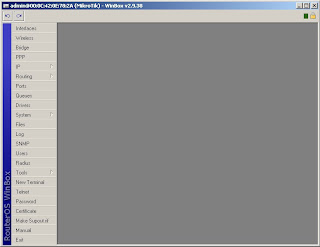
Once you have assigned the AP an ip address it can also be accessed using PuTTY.
2. MikroTik Bridged AP setup

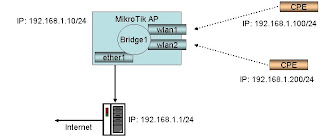
In this, the simplest setup we will create a dual access point (i.e. two radios, both set as an AP) and bridge all the interfaces. The internet is accessed through a server connected to the wired interface.
1) Select Bridge
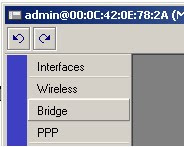
2) Click on the red ‘+’ to add a new bridge
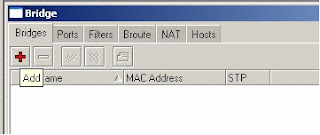
3) Accept all defaults and click on ok
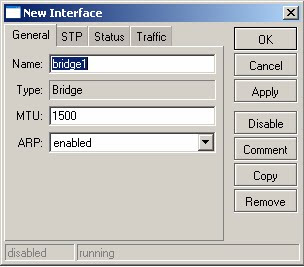
4) Click on the Ports tab

5) Click on the red ‘+’ to add a new port
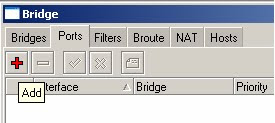
6) Select Interface -> ether1, Bridge -> bridge1
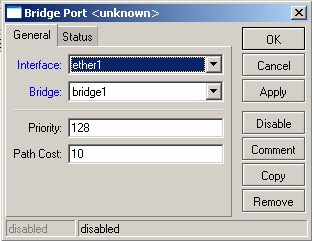
7) Click on the red ‘+’ again. This time select Interface -> wlan1, Bridge -> bridge1
8) Click on the red ‘+’ again. This time select Interface -> wlan2, Bridge -> bridge1
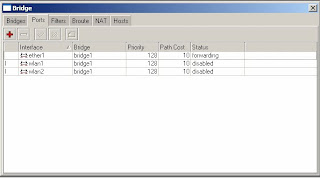
9) Close the Brige window
10) Click on IP - > Addresses
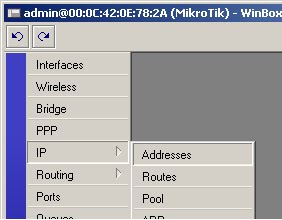
11) Click on the red’+’ to add an address
12) Enter the ip adderss 192.168.1.10/24 in the address field
13) In the interface drop down list box select bridge 1, the click on ok
*NOTE* All address formats in MikroTik are in address/subnet format, i.e. 192.168..1.1/24. For a more detailed explanation of this notation please see the appendix at the end of this document.
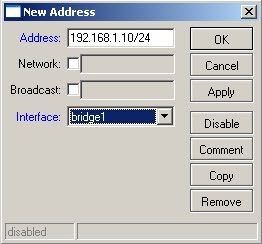
14) Close the Address List dialog box
15) Select Interfaces
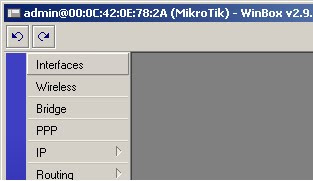
16) Double click on wlan1 to configure
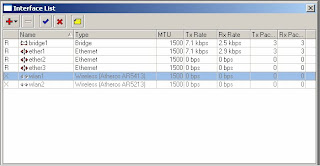
17) Click on the wireless tab

18) In the Mode drop down select ap bridge
19) Enter the desired SSID in the SSID field
20) In the Band drop down select either 5GHz or 2.4GHz-B
*NOTE* Wi-Pipe recommends using 802.11b only at 2.4 GHz as this standard has more robust signals *NOTE* Wi-Pipe recommends not using the same SSID on multiple AP’s as this can cause circular networks. These will cause error’s in your network and may prevent you from accessing your AP remotely.
21) In the Frequency field enter the desired frequency
22) Click on ok to save changes

23) Repeat for wlan2 (remember not to use the same SSID on both radio’s)
24) Select wlan1 and click on the blue to enable the interface

25) Select wlan2 and click on the blue to enable the interface
26) Close the Interface List window
27) Select IP -> Routes

28) Click on the red ‘+’ to add the default route
29) In the destination field enter the address 0.0.0.0/0 (this is the notation for the default route)
30) In the gateway field in the ip address 192.168.1.1

31) Click on ok to save changes

3. MikroTik Routed Setup

This guide highlights the differences between a bridged and a routed setup. Note this assumes you have not created the bridge and have not yet assigned an ip address to any interface.
1) Click on IP -> Address
2) Click on the red ‘+’ to add an address
3) Enter the ip address 192.168.1.10/24, Interface -> ether1
4) Click on the red ‘+’ to add another address
5) Enter the ip address 10.0.10.1/24, Interface -> wlan1
6) Click on the red ‘+’ to add another address
7) Enter the ip address 10.0.20.1/24, Interface -> wlan2

8) Click on IP -> Routes and add 192.168.1.1 as the default route as per steps 27 to 31 above.
9) Click on IP -> Firewall

10) Click on the NAT tab
11) Click on the red ‘+’ to add a new NAT rule
12) Select Chain -> srcnat, Out Interface -> ether1

13) Click on the action tab
14) Select masquerade from the Action list box

15) Click on ok to save
4. Adding WPA / WPA2 Security to your AP
1) Click on the wireless button
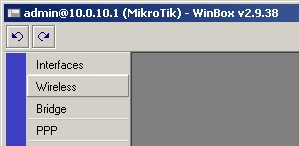
2) Click on the Security Profiles tab

3) Click on the red ‘+’ to add a new profile
4) Enter a name for the profile in the name field
5) Enter the WPA pass phrase in the WPA pre-shared key field
6) Enter the WPA2 pass phrase in the WPA2 pre-shared key field
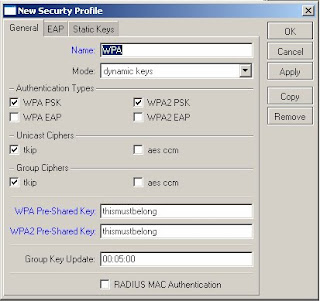
7) Click on ok to save
8) Click on the Interfaces tab
9) Double click on wlan1 to configure
10) Click on the wireless tab
11) In the security drop down select the new security profile
12) Click on ok to save
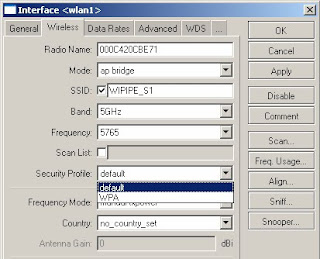
5. Setting up a WDS Bridge 1) Click on Bridge
2) Click on the red ‘+’ to add a new bridge
3) Enter details and click on ok
4) Click on Wireless
5) Double click on the wireless interface to configure
6) Select the wireless tab
7) In the mode drop down select bridge
8) In the band drop down select 5GHz or 2.4GHz-b as appropriate
9) In the Frequency enter the desired frequency
10) Click on the WDS tab
11) In the WDS mode tab select static
12) In the WDS default bridge drop down select the bridge created in step 2 above
13) Check the WDS Ignore SSID check box
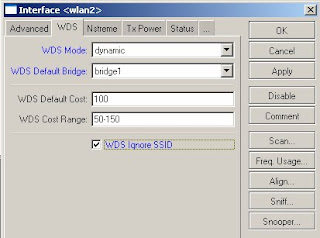
14) Click on ok to save changes
15) Click on the red ‘+’ and select WDS to add a new WDS interface

16) Click on the WDS tab
17) From the Master Interface tab select the desired wireless interface
18) Enter the MAC address of the other side of the link in the WDS address field
19) Click on ok to save
20) Repeat steps on second AP to create the bridge connection.
6. Backing up and Restoring AP configurations
To backup your configuration :
1) Click on files
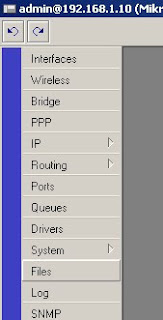
2) Click on backup
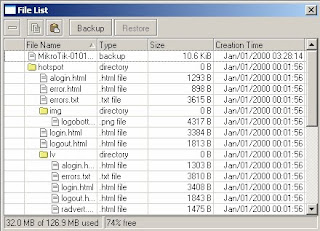
3) The system configuration will automatically be saved
4) To download the file, ftp to the router and download the file
To restore your configuration :
1) Open an ftp connection to the router and upload the configuration file
2) Click on files
3) Select the backup file and click on restore
7. Appendix C: Trouble Shooting
Winbox unable to find router locally connected to PC
Remedial steps :
- Ensure router is powered up
- Ensure router has fully booted, this can take more than 60 seconds
- If router has ip address ensure PC has an ip address on same subnet
- Ensure cross over cable is used from PoE injector to PC
- Ensure the cross over cable is not damaged
- Check the PC shows the Ethernet port has a connection. To do this start a command prompt. At the command prompt enter the command ‘ipconfig’. If ‘Media Disconnected’ is displayed, check all cables for damage.
- Ensure no firewalls etc. are running on the PC which would prevent it from accessing the router on all ports
- Attempt the same operation on a separate PC
If after performing all of the above steps you still cannot access the AP, fill out the RMA form http://www.wi-pipe.com/docs/Returns%20Form.pdf and return to Wi-Pipe for further investigation. Wi-Pipe will check the unit once received and report on whether the unit is faulty or not.
Winbox connects to router, and then immediately disconnects
Remedial steps :
- Try to connect by entering the ip address rather than the MAC address of the router into the Winbox connection screen
- Deselect the secure mode check box before connecting to the router
- Ensure the PC does not have an enabled wireless interface. If it does, disable the wireless interface and attempt to connect again
- Attempt the same operation of a separate PC
If after performing the above steps you still cannot access the AP perform either of the following steps :
- Download and start PuTTy (http://the.earth.li/~sgtatham/putty/latest/x86/putty.exe)
- Enter the AP’s ip address and click on open
- Enter login of admin and press enter
- If asked for a password leave blank and hit enter
- Reset the system by entering the command /system reset at the command prompt
- When asked are you sure, select y and hit enter
- When the system has been reset, try and access it using Winbox again
If after performing all of the above steps you still cannot access the AP, fill out the RMA form http://www.wi-pipe.com/docs/Returns%20Form.pdf and return to Wi-Pipe for further investigation. Wi-Pipe will check the unit once received and report on whether the unit is faulty or not.
AP Reboots erratically
This can be cause by many wireless interfaces having the same SSID causing many circular networks, poor power supply or board malfunction.
Remedial actions:
- Select Wireless
- Select each of the wireless interfaces and click on the red ‘x’ to disable them
- Wait to see if router reboots. If not, amend the SSID’s so they are not all the same
If after performing all of the above steps you still cannot access the AP, fill out the RMA form http://www.wi-pipe.com/docs/Returns%20Form.pdf and return to Wi-Pipe for further investigation. Wi-Pipe will check the unit once received and report on whether the unit is faulty or not.
AP Reboots erratically
This can be cause by many wireless interfaces having the same SSID causing many circular networks, poor power supply or board malfunction.
Remedial actions:
- Select Wireless
- Select each of the wireless interfaces and click on the red ‘x’ to disable them
- Wait to see if router reboots. If not, amend the SSID’s so they are not all the same
If after performing all of the above steps you still cannot access the AP, fill out the RMA form http://www.wi-pipe.com/docs/Returns%20Form.pdf and return to Wi-Pipe for further investigation. Wi-Pipe will check the unit once received and report on whether the unit is faulty or not.
Other Issues
If you have any other problems with you AP, please main details of the problem to info@wi-pipe.com. Include in the mail which of the setup’s above you were attempting, symptoms and as many screen shots as possible, especially the Status tab from the wireless configuration menu.
8. Appendix D: Further Information
If you require further assistance it can be found at :
Manuals
http://www.mikrotik.com/testdocs/ros/2.9/
MikroTik FAQ
http://wiki.mikrotik.com/wiki/MikroTik_RouterOS_Frequently_Asked_Questions_-_FAQ
MikroTik Forum
http://forum.mikrotik.com/
MikroTik Support
Support@mikrotik.com
If you would like guidance on more complicated setups please contact Wi-Pipe at + (0) 51 387 753 or info@wi-pipe.com
1 comments:
Very informative post. Keep up the good work. I would really look forward to your other posts
Dell - Refurbished - 13" Latitude Notebook - 2 GB Memory - 320 GB Hard Drive
Dell - Refurbished - 13" Latitude Notebook - 4 GB Memory - 320 GB Hard Drive (E4310)
Post a Comment